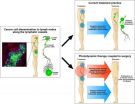(Press-News.org) With cholera on the rampage in Haiti and almost 40 other countries, scientists are reporting the development of a key advance that could provide a fast, simple test to detect the toxin that causes the disease. The report appears in ACS' journal Bioconjugate Chemistry. Cholera affects more than 200,000 people annually, mainly in developing countries, and causes about 5,000 deaths. Many involve infants, children, and the elderly.
J. Manuel Perez and colleagues note that cholera is an intestinal infection from food or water contaminated with the bacterium Vibrio cholerae. It produces a toxin that can cause severe diarrhea, which can lead to rapid dehydration and death. Prompt treatment thus is essential, and yet existing tests to diagnose cholera are time-consuming, expensive, and require the use of complex equipment.
The scientists describe a key advance toward a better, faster test. The new method uses specially prepared nanoparticles of iron oxide, each barely 1/50,000th the width of a single human hair, coated with a type of sugar called dextran. To achieve this, they looked for specific characteristics of the cholera toxin receptor (GM1) found on cells' surface in the victim's gut, and then they introduced these features to their nanoparticles. When the magnetic nanoparticles are added to water, blood, or other fluids to be tested, the cholera toxin binds to the nanoparticles in a way that can be easily detected by instruments. The test hardware can be turned into portable gear that health care workers could use in the field, the scientists say. The approach also shows promise for treating cholera intoxication.
###
The authors acknowledge funding from the National Institute of General Medical Sciences at the National Institutes of Health.
ARTICLE FOR IMMEDIATE RELEASE
"Identification of Molecular-Mimicry-Based Ligands for Cholera Diagnostics using Magnetic Relaxation"
DOWNLOAD FULL TEXT ARTICLE
http://pubs.acs.org/stoken/presspac/presspac/full/10.1021/bc100442q
CONTACT:
J. Manuel Perez, Ph.D.
Assistant Professor
Nanoscience Technology Center,
Chemistry Department and Burnett College of Biomedical Sciences University of Central Florida
12424 Research Parkway, Suite 400
Orlando, FL 32826
Toward a fast, simple test for detecting cholera rampaging in 40 countries
2011-02-10
ELSE PRESS RELEASES FROM THIS DATE:
A green way to cap an old landfill
2011-02-10
This release is available in Spanish.
U.S. Department of Agriculture (USDA) scientist Pat Millner and safety manager David Prevar have worked with the U.S. Environmental Protection Agency (EPA) and private consultants to design and conduct a pilot study for an alternative way to cap landfills.
Millner is a microbiologist at the 6,615-acre Henry A. Wallace Beltsville Agricultural Research Center (BARC) operated in Beltsville, Md., by the Agricultural Research Service (ARS), the chief intramural scientific research agency of USDA.
Prevar oversees safety and health issues ...
Photodynamic therapy against cancer
2011-02-10
Tumor cells have several routes that enable them to move from the primary tumor to distant tissues, a process called metastasis. It is metastasis of the primary tumor that kills most cancer patients. One of the least studied routes of metastasis is the lymphatic system. Many tumors produce factors that promote the formation of new lymphatic vessels (lymphangiogenesis). The newly formed lymphatic vessels enable tumor cells to travel from the primary tumor to the regional lymph nodes from whence they can spread throughout the body.
Current treatment practice is to surgically ...
Challenges for biofuels: New life cycle assessment report from Energy Biosciences Institute
2011-02-10
A combination of rising costs, shrinking supplies, and concerns about global climate change are spurring the development of alternatives to the burning of fossil fuels to meet our transportation energy needs. Scientific studies have shown the most promising of possible alternatives to be liquid fuels derived from cellulosic biomass. These advanced new biofuels have the potential to be clean-burning, carbon-neutral and renewable. Some could also be delivered through existing pipelines and used in today's engines, replacing gasoline on a gallon-for-gallon basis with no loss ...
AGU journal highlights -- Feb. 9, 2011
2011-02-10
No tipping point for Arctic Ocean ice, study says
Using microearthquakes to evaluate potential carbon sequestration sites
Observing flares from Jupiter's aurora
Change in atmospheric patterns behind Arctic sea ice summer 2010 low
Antarctic ice sheet melting would affect sea ice margin, marine food chain
Simulating ocean carbon storage during the Last Glacial Maximum
Anyone may read the scientific abstract for any already-published paper by clicking on the link provided at the end of each Highlight. You can also read the abstract by going to http://www.agu.org/pubs/search_options.shtml ...
Night games in sports stadiums and street lighting can cause spike in daytime ozone air pollution
2011-02-10
Brightly-lit Cowboys Stadium during Sunday's Super Bowl XLV may symbolize one of the hottest new pieces of scientific intelligence about air pollution: Researchers have discovered — in a classic case of scientific serendipity — that the bright light from sports stadiums and urban street lights may boost daytime levels of ozone, a key air pollutant in many heavily populated areas. That's among the topics included in a broader article about the chemistry of air pollution in the current edition of Chemical & Engineering News (C&EN), ACS' weekly newsmagazine.
In the article, ...
Young people now take longer to join adult life
2011-02-10
A research study by the Autonomous University of Barcelona (UAB), in collaboration with the State University of Campinas (Brazil), shows that young Spanish people were by 2001 taking six years longer than in 1981 to reach full employment, residential and family independence.
Spain considers itself to be a "family-centred" country, in other words, families are expected to take up the slack with regard to areas not covered by social security. "The objective was to evaluate transformations in the trends of how young people gained their independence in Spain over the last ...
Sweeping view of prostate cancer genome yields deep insights
2011-02-10
NEW YORK, CAMBRIDGE, Mass., AND BOSTON (Feb. 9, 2011) -- For the first time, researchers have laid bare the full genetic blueprint of multiple prostate tumors, uncovering alterations that have never before been detected and offering a deep view of the genetic missteps that underlie the disease. The study, made possible by key advances in whole genome sequencing and analysis, points to several new prostate cancer genes and a critical category of genomic changes as important drivers of prostate cancer growth. The work was led by researchers from Weill Cornell Medical College, ...
What makes fructose fattening? OHSU researchers find some answers in the brain
2011-02-10
PORTLAND, Ore. – The dietary concerns of too much fructose is well documented. High-fructose corn syrup has become the sweetener most commonly added to processed foods. Many dietary experts believe this increase directly correlates to the nation's growing obesity epidemic. Now, new research at Oregon Health & Science University demonstrates that the brain – which serves as a master control for body weight – reacts differently to fructose compared with another common sweetener, glucose. The research is published in the online edition of the journal Diabetes, Obesity and ...
Stardust NExT set to meet its second comet
2011-02-10
Stardust NExT must love comets. On Valentine's Day the spacecraft will get up close and personal with its second.
It's been seven years since the original Stardust danced with Wild 2 out beyond the orbit of Mars, capturing a thimbleful of comet dust in its collector. It's been five years since the craft jettisoned its sample-return capsule and its precious cargo for a landing in the Utah desert.
Next Monday the probe will make history again in a 125-mile embrace with comet Tempel 1. It will be the first time two different comets have been surveyed with the same set ...
Delving into manganite conductivity
2011-02-10
Washington, D.C.—Chemical compounds called manganites have been studied for many years since the discovery of colossal magnetoresistance, a property that promises important applications in the fields of magnetic sensors, magnetic random access memories and spintronic devices. However, understanding—and ultimately controlling—this effect remains a challenge, because much about manganite physics is still not known. A research team lead by Maria Baldini from Stanford University and Carnegie Geophysical Laboratory scientists Viktor Struzhkin and Alexander Goncharov has made ...



